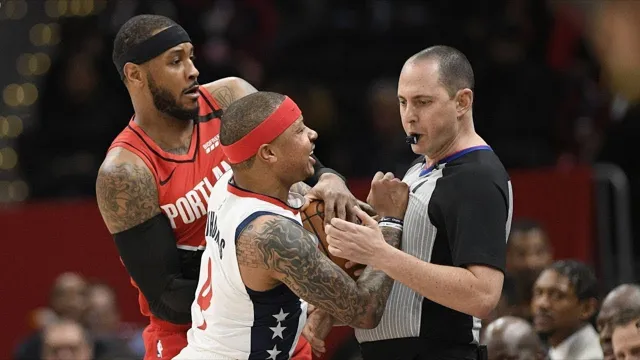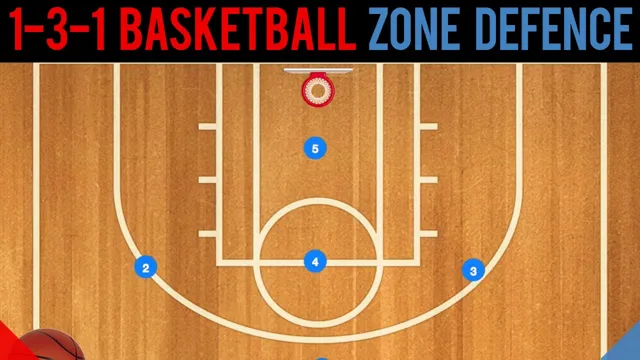Basketball is a game that thrives on passion and intensity, making it one of the most thrilling and competitive sports in the world. However, this same energy and intensity can sometimes result in disagreements, confrontations, and even ejections. As a basketball player, coach, or fan, it is crucial to understand the rules and consequences surrounding basketball ejections.
In this blog post, we will delve into the different scenarios that can lead to ejections, the rules surrounding them, and the potential consequences for both players and teams. So, if you want to stay on top of your game and keep your team from falling apart due to a preventable mistake, read on to learn everything you need to know about basketball ejections.
What is a basketball ejection?
A basketball ejection occurs when a player, coach, or even a fan is removed from the game by the referee. This is usually the result of a serious violation, such as physical contact with an opponent, intentional fouling, or unsportsmanlike conduct. An ejection may also occur if a player accumulates too many fouls or receives a technical foul.
The ejected individual must leave the court and is not allowed to participate in the game any further. In some cases, the offender may face additional penalties, such as fines or suspensions. Basketball ejections are taken very seriously and can significantly impact the outcome of a game, as the ejected player can no longer contribute to their team’s performance.
It’s important for players and coaches to practice good sportsmanship and avoid behavior that could lead to an ejection, in order to keep the game fair and enjoyable for everyone involved.
Definition and Types
Basketball ejection is the act of a player or a coach being forced to leave the game and the playing area due to a violation of rules or poor conduct. The decision to eject a player or coach is usually made by the officials on the court, who have the power to do so when necessary. Ejections can occur for various reasons, including technical fouls, unsportsmanlike conduct, or physical altercations.
Technical fouls can result from actions such as excessive complaining to a referee, taunting or disrespecting an opponent, or showing dissent with a call. The type of ejection and the consequences can vary, with some leading to immediate disqualification from the game and others to fines or suspension in subsequent games. Overall, basketball ejections serve as an important way to maintain fair play and sportsmanship in the game.

Common Reasons for Ejection
Basketball ejections occur when a player or coach is forcibly removed from the game due to a violation of certain rules or egregious behavior on the court. The most common reasons for an ejection in basketball include committing violent or aggressive acts, being verbally abusive towards officials or other players, or accumulating multiple technical fouls. These actions are not only frowned upon by the league but can also put the safety of other players at risk.
Other factors that may lead to an ejection include leaving the bench to participate in a fight or altercation, making inappropriate gestures or comments towards fans, or purposely delaying the game. It’s important for players and coaches to understand the rules and expectations of the game, as an ejection can result in significant penalties such as fines or suspensions. Ultimately, the goal is to maintain an atmosphere of respect and sportsmanship on the court, and ejections serve as a necessary measure to enforce this standard.
Consequences of Ejection
When a basketball player is ejected from a game, the consequences can be significant. Not only does the player have to leave the court and cannot return for the remainder of the game, but there could also be further consequences. The player may receive fines, suspension, or even affect their reputation.
Being ejected from a game can also have negative effects on the team, as they are left without one of their players, and the remaining players must step up their game to make up for the loss. Additionally, the ejected player may feel embarrassed or angry, which can affect their mentality in future games. Therefore, players should always be aware of their actions on the court to avoid being ejected and facing the potential consequences.
Suspensions and Fines
The consequences of ejection are suspension and fines, and they are not to be taken lightly. Being ejected or thrown out of a game can severely impact an athlete’s performance, reputation, and chances of future success. The suspension varies in length depending on the severity of the offense and can range from one game to an indefinite suspension.
This can not only hurt the athlete’s individual performance but can also negatively impact the team’s chances of success. Furthermore, fines can also be imposed on athletes for their actions, and these fines can be quite hefty. For example, in the NBA, a player can be fined up to $50,000 for actions such as abusive language towards a referee or fighting.
These fines can cause a significant financial burden on some of the lower-paid athletes. In summary, being ejected from a game can have severe consequences, and athletes must control their emotions and actions on the field to avoid these harsh punishments.
Impact on the Team and the Game
When a player is ejected from a game, it can have significant consequences for both their team and the overall outcome of the game. The most immediate impact is that the team will have to continue playing with one less player, which can put them at a disadvantage. This is especially true if the ejected player was a key player or played an important role on the team.
Their absence can disrupt team dynamics and change the strategy of the game. Additionally, if the ejection happens early in the game, it can put the team in a difficult position for the rest of the match. The consequences are not just limited to the current game either.
Depending on the reason for the ejection, the player may face disciplinary action from their league or governing body, which could result in fines or even suspension for future games. In the end, it’s clear that an ejection can have a ripple effect that impacts not just the player, but their team and the game overall.
Preventing and Appealing Ejection
If you’ve been ejected from a basketball game, it’s important to know your options for preventing future ejections and appealing the one you received. Prevention is key, so be sure to act respectfully towards the officials and avoid any aggressive or unsportsmanlike behavior. If you do receive an ejection, it’s important to stay calm and avoid any further outbursts.
When it comes to appealing an ejection, it’s important to understand the process and have a legitimate reason for doing so. You can generally appeal an ejection by submitting a written or verbal complaint to the league, along with any supporting evidence or witness statements. While it can be frustrating to be ejected, it’s important to remember that the officials are there to ensure fair play and keep the game safe for all players.
By approaching the situation calmly and respectfully, you can minimize the risk of future ejections and ensure that any appeals are taken seriously by the league.
Behavioral Tips for Players and Coaches
Preventing and Appealing Ejection in sports is essential for players and coaches. Ejections happen due to a variety of reasons such as unsportsmanlike conduct, dangerous play, or aggressive behavior. However, it’s important to remain calm and collected, even in heated moments.
Players should focus on their body language and tone when speaking to officials. Coaches should also model positive behavior and encourage their team to avoid confrontation. In the event of an ejection, it’s vital to appeal the decision in a respectful and professional manner.
The goal is to minimize the impact of an ejection on the team’s performance and reputation. Understanding the rules, remaining calm, and appealing respectfully are key factors to prevent and appeal ejections in sports.
Procedures and Requirements for Appealing
Preventing and Appealing Ejection can be a stressful and overwhelming experience. It’s essential to understand the procedures and requirements for appealing when faced with ejection to prevent it from happening altogether. The best way to avoid ejection is to follow the rules and policies set forth by the organization.
If, for any reason, you do find yourself ejected, make sure to gather all necessary information and evidence to support your case. Most organizations will provide you with a process for appealing ejections, which often includes documentation and an appeals board. It’s crucial to review and understand the guidelines for maneuvering through this process effectively.
Remember, staying calm and respectful throughout this experience will increase your chances of having a successful appeal. By taking the necessary steps to prevent ejection and being prepared to appeal, you can protect your rights and ensure a fair resolution.
Famous Incidents of Basketball Ejection
Basketball ejection incidents are not uncommon, and they have happened at both college and professional levels. One famous incident that occurred during a college basketball game was in 1995 when Bobby Knight, the coach for Indiana University, was ejected for throwing a chair onto the court during a game against Purdue. This incident led to a suspension for Knight and a change in his coaching behavior.
Another noteworthy ejection occurred in the NBA during a game between the Golden State Warriors and Sacramento Kings when Draymond Green was ejected for arguing with an official. The incident caused a lot of controversy, and many people criticized Green for not respecting the authority of the game. Other notable basketball ejections include Charles Barkley’s ejection for threatening to beat up an opposing player and Rasheed Wallace’s ejection for arguing with a referee.
Overall, basketball ejections are a serious matter that can have significant consequences for players and coaches alike.
Historic and Recent Cases
Basketball Ejection Basketball is a game of passion, and sometimes that passion can overflow into negative behavior. There have been many historic and recent cases of famous basketball players being ejected from games for unsportsmanlike conduct. One of the most infamous incidents occurred in 1997 when Dennis Rodman was ejected for kicking a cameraman during a game.
Another notable example is when Ron Artest, now known as Metta World Peace, was ejected and suspended for 86 games for his involvement in the infamous “Malice at the Palace” brawl between the Indiana Pacers and Detroit Pistons. More recently, Golden State Warriors’ forward, Draymond Green, was twice ejected during the 2016 NBA Finals for his fiery behavior on the court. Despite the excitement these moments can bring to the game, it’s important for players to remember to play with respect for their opponents and the sport.
Conclusion
Sometimes in basketball, emotions run high and players may find themselves ejected from the game. But don’t worry, it’s not the end of the world – just a reminder to keep a cool head and play by the rules. So next time you’re on the court, remember to focus on the game and leave the drama on the sidelines.
“
FAQs
What is a basketball ejection?
A basketball ejection occurs when a player is forcibly removed from the game by the referees for breaking a rule or being excessively aggressive.
What are some common reasons for a basketball ejection?
Common reasons for a basketball ejection include unsportsmanlike conduct, physical altercations with other players or officials, and excessive fouls.
Can a basketball player be ejected for arguing with a referee?
Yes, a basketball player can be ejected for arguing with a referee if the argument becomes too aggressive or the player becomes belligerent.
What happens to a team when a player is ejected from a basketball game?
When a player is ejected from a basketball game, their team is forced to play with one less player for the remainder of the game. This can make it much harder for them to win.


